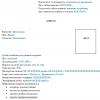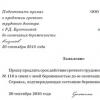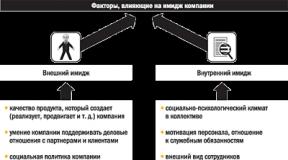Should I take methyluracil tablets? Methyluracil - instructions for the use of ointments, tablets and counters, reviews Methyluracil instructions for use
Methyluracil is a drug that improves tissue trophism and stimulates the regeneration process.
This drug promotes the formation of leukocytes, the growth of tissues and epithelium, stimulates cellular and humoral recovery. Methyluracil has an anti-inflammatory and photoprojector effect on the affected areas. It is used for diseases internal organs, contributing to the stimulation of nucleic acid metabolism in the soft mucous membranes.
It is able to synthesize new muscle and tissue cells, which are formed under the influence of hormones. Since the drug is manufactured in different forms, it stipulates it wide range application.
Clinical and pharmacological group
Immunostimulating agent, dioxomethyltetrahydropyrimidine.
Conditions of dispensing from pharmacies
Dispensed by prescription.
Prices
How much do Methyluracil candles cost? The average price in pharmacies is 50 rubles.
Release form and composition
- Suppositories (suppositories) Methyluracil. In one suppository, methyluracil 500 mg. Available in packs of 10.
- Methyluracil tablets. One tablet contains 500 mg of methyluracil. The tablets are packaged in convolutes and are sold in 50 or 100 pieces.
- Ointment Methyluracil. The ointment contains methyluracil in an amount of 100 mg per 1 g (10%). Available in 25 g aluminum tubes.
Auxiliary components: ointment and suppositories contain alcohols, paraffins and macrogol; tablets - potato starch.
Pharmacological effect
The main active substance of methyluracil tablets is classified as a stimulant of leukopoiesis and erythropoiesis, but in addition, Methyluracil is able to stimulate metabolic processes in tissues, promotes their regeneration.
How does Methyluracil work? As a precursor of purines, Methyluracil promotes the activation of nucleic acid synthesis. The obtained DNA and RNA work to restore the number of leukocytes, activate the processes of regeneration of damaged tissues.
By starting the process of leukocyte recovery, the drug accelerates:
- regeneration of muscle tissue;
- growth and granulation maturation of tissues;
- restoration of humoral and cellular factors of immunity.
Indications for use
Methyluracil tablets are prescribed in the presence of mild forms of leukopenia in history, which appeared as a result of the progression of acute radiation sickness, with frequent X-rays or after chemotherapy, also in the presence of malignant oncology. The medication is also prescribed for malignant forms of anemia, thrombocytopenia, various intoxications and poisoning. As a means to restore the body, tablets can be prescribed after lingering inflammatory diseases.
Methyluracil suppositories treat ulcerative, proctitis. Also, the medication will well help eliminate burns, diaper rash, accelerate the restoration of bone tissue after fractures, the wound heals faster when using external forms of release. Suppositories in gynecology, which need to be inserted into the vagina, although they are rectal, are prescribed for the healing of erosions, colpitis, vulvitis.
The use of the ointment is indicated in the treatment of cracks, for the healing of wounds and cuts. Also, methyluracil is used for acne externally, as it helps to heal inflamed formations.

uses methyluracil for acne externally, as it helps to heal inflamed formations.
Contraindications
Methyluracil is contraindicated if the patient has lymphogranulomatosis, as well as chronic and acute leukemic forms of leukemia. The drug should not be used for malignant neoplasms in the gastrointestinal tract, if the patient is hypersensitive to one or more of the components that make up the drug.
Use during pregnancy and lactation
During pregnancy, the drug in the form of tablets should be used in exceptional cases: when the risk to the fetus is much lower than the benefit to the mother.
Ointment and suppositories have no contraindications for use during pregnancy. During the feeding period, it is better if it is impossible to exclude tablets, it is better to replace breast milk mixtures.
Dosage and method of administration
The instructions for use indicate that the tablets are taken orally, the ointment is used externally, and the suppositories are prescribed for rectal use.
Ointment
Methyluracil in the form of an ointment should be applied daily in a thin layer to the damaged area.
The doctor sets the dosage regimen individually. The frequency of dressing changes is determined by the depth and area of the wound surface, the intensity of exudation, and the presence of necrotic masses. In the treatment of radioepithelitis and late radiation injuries of the vagina, the ointment is used in loose tampons.
In the treatment of acute bullous radiation dermatitis, ulcers, wounds and burns, Methyluracil can be used simultaneously with external applications of sulfonamides, antiseptic and antibiotic agents.
Candles
Methyluracil suppositories are prescribed in the following dosages:
- 500 - 1000 mg (1 - 2 suppositories), 3 - 4 times a day for adults;
- 250 mg (half a candle) per day for children from 3 to 8 years old;
- 500 mg (1 suppository) per day for children from 8 to 14 years old.
The optimal course of drug treatment is established by the attending physician. It usually lasts 10 to 14 days. In severe cases, the course of treatment can be continued up to 120 days.
When using rectally, it is necessary to clear the anus from feces... For this, it is recommended to do oil enemas, which allow you to cleanse the rectum without damaging the mucous membrane.
After defecation, you need to rinse the anus with warm water and then inject a suppository.
When using vaginal suppositories, women are advised to pre-douch. The vagina is washed with a decoction of chamomile or warm water with a small amount of soda dissolved in it. The candle is inserted in a supine position.
To prevent the contents of the candle from leaking out after the introduction, it is recommended to lie down for at least 30 minutes after using it.
Tablets
The tablets are drunk after or during a meal. The dosage depends on the age:
- Adults and adolescents from the age of 14 take Methyluracil 1 tablet (500 mg), 4 to 6 times a day.
- Children from 3 to 8 years old take half a tablet (250 mg), 3 times a day.
- Children from 8 to 14 years old take half or a whole tablet (250 mg or 500 mg), 3 times a day.
In this case, adults can take a maximum of 3 g per day (6 pieces) of Methyluracil tablets, children 3 to 8 years old - 750 mg (1.5 pieces), and children 8 to 14 years old - 1.5 g (3 pieces).
The duration of the course of therapy for organ damage digestive system (peptic ulcer stomach and duodenum, hepatitis, pancreatitis, ulcerative colitis, enteritis, etc.) is 30 - 40 days. Disease therapy gastrointestinal tract is the most durable. Therefore, in the treatment of other pathologies, Methyluracil tablets are used in shorter courses, the duration of which is determined by the speed of recovery and the normalization of a person's well-being.
Side effects
When using Methyluracil, allergic reactions may develop.
Also, during therapy, you may experience:
- Dizziness, headache, heartburn (if taken orally);
- Short-term slight burning sensation (when applied externally).
Overdose
To date, no cases of significant excess of the recommended therapeutic dosage of Methyluracil tablets have been reported.
special instructions
Dosage forms of methyluracil should be used strictly according to the appropriate indications.
Drug interactions
Strengthens the anti-radiation effect of cystamine.
Methyluracil is a stimulant of immunity and tissue regeneration. In various dosage forms (tablets, ointments, suppositories), it is produced by a number of domestic enterprises: Biochemist, Nizhpharm, Obnovlenie, Rosbio, Valenta Pharmaceuticals, Altayvitamins, Dalkhimpharm, Synthesis, etc. Stimulates the growth and reproduction of cells, acting as a repair agent and accelerating the recovery of damaged tissues. Promotes the fastest healing of wounds, erosive and ulcerative lesions, burns. Increases the body's resistance to the invasion of bacterial and viral agents. Normalizes protein metabolism, activates cell regeneration in the damaged area, accelerates tissue epithelization, strengthens cellular and humoral immunity. Shows anabolic activity. External forms have a photoprotective effect. A distinctive feature of the drug is its ability to stimulate hematopoiesis (to activate the formation of white and red blood cells in the bone marrow). In addition to this, methyluracil exhibits an anti-inflammatory effect, increases the body's tolerance to blood loss and hypoxia, and normalizes gastric secretion and acid-base balance gastric juice. The tablet form of methyluracil is prescribed for the treatment of mild forms of leukopenia (including those developed as a result of chemotherapy malignant tumors, radio- or X-ray therapy), ulcerative necrotic lesions of the pharynx and tonsils, septic sore throat, anemia, decreased platelet count, benzene poisoning, ulcerative erosive lesions of the gastric mucosa and duodenal ulcer, slowly healing wounds, burns, bone fractures, hepatitis, etc. ...
e. The external form (ointment) is used to treat slowly healing wounds, burns, so-called. " sun allergies"(Photodermatitis), trophic ulcers of the lower and upper extremities, bedsores. Local forms (suppositories) are used for inflammation of the mucous membrane of the direct and sigmoid colon, ulcerative colitis. Methyluracil has a relatively small amount side effects: it allergic reactions, and for internal forms - vertigo, headaches, heartburn. The drug is contraindicated in case of hypersensitivity to active ingredient, leukemia, malignant processes in the bone marrow, excessive wound granulation (for external and local forms). Methyluratsyal in the form of an ointment goes well with external applications of disinfecting and antibacterial agents. Clinically significant interactions (increase or decrease in the action of drugs with joint application) for methyluracil has not been established. A number of sources (mainly of the Soviet period) indicated the possibility of using methyluracil tablets to stimulate anabolic processes during sports, but not a single study was conducted that would confirm the effectiveness of the drug for sports purposes.
Pharmacology
Immunostimulating agent, dioxomethyltetrahydropyrimidine. Promotes the normalization of nucleic acid metabolism, accelerates the processes of cellular regeneration in wounds, accelerates the growth and granulation maturation of tissue and epithelization (including in rapidly proliferating cells of the gastrointestinal mucosa), stimulates erythro- and leukopoiesis, cellular and humoral factors of immunity. Possesses anabolic activity, anti-inflammatory effect. When applied externally, it also has a photoprotective effect.
Release form
10 pieces. - contour cell packaging (5) - cardboard packs.
Dosage
Inside, during or after meals, 500 mg 4 times / day (if necessary, up to 6 times / day); children from 3 to 8 years old - 250 mg, over 8 years old - 250-500 mg 3 times / day. The course for diseases of the digestive tract - 30-40 days; in other cases it may be shorter.
When applied externally, the dosage regimen is set individually, depending on the dosage form used. The frequency of dressing changes depends on the depth and area of the wound surface, the intensity of exudation and the presence of necrotic masses.
Rectally used in adults, 0.5-1 g 3-4 times / day; in children aged 3-8 years - 250 mg / day, at the age of 8-15 years - 500 mg / day. The course of treatment is from 1 week. up to 4 months
Side effects
Possibly: allergic reactions; when taken orally - headache, dizziness, heartburn.
Indications
For oral administration: leukopenia (mild forms, including those resulting from chemotherapy of malignant neoplasms, with X-ray and radiation therapy), agranulocytic tonsillitis, alimentary toxic aleukia, anemia, thrombocytopenia, benzene intoxication, radiation sickness, convalescence (after severe infections), gastric ulcer and duodenal ulcer, sluggish wounds, burns, bone fractures, hepatitis, pancreatitis.
For external use: sluggish wounds, burns, bone fractures, photodermatitis; trophic ulcers, bedsores, deep wounds.
For topical use: proctitis, sigmoiditis, ulcerative colitis.
Contraindications
Hypersensitivity to methyluracil.
For oral administration: leukemia (leukemic forms, especially myeloid), lymphogranulomatosis, hemoblastosis, malignant diseases bone marrow.
For external and local use: excessive granulation in the wound.
Application features
special instructions
Dosage forms of methyluracil should be used strictly according to the appropriate indications.Methyluracil is a drug that activates metabolism in tissues, improves trophism, accelerates the processes of cell regeneration, growth and granulation maturation of tissue, epithelization. In addition, the drug has anabolic activity, has an anti-inflammatory effect, and when applied externally, it is photoprotective.
Release form and composition
The drug is produced in the form of tablets for oral administration, 10% ointment for external use and rectal suppositories.
The active component of methyluracil is dioxomethyltetrahydropyrimidine (methyluracil), which is a stimulant of erythro- and leukopoiesis. One tablet and one suppository contains 500 mg, one gram of ointment - 100 mg.
Indications for use
According to the instructions for Methyluracil, in the form of tablets, this drug is intended for the treatment of:
- Mild forms of leukopenia (a condition characterized by a decrease in the number of leukocytes in the blood), including those developed during chemotherapy for malignant neoplasms and radiation therapy;
- Agranulocytic angina (inflammation of the lymphadenoid tissue of the pharynx, accompanied by the absence or a sharp decrease in the content of granulocytes in the blood);
- Alimentary-toxic aleukia (food mycotoxicosis resulting from the consumption of products made from overwintered agricultural crops infected with the fungus Fusarium sporotrichioides);
- Anemia (a condition caused by a decrease in the concentration of hemoglobin in the blood);
- Thrombocytopenia (a condition characterized by a low number of platelets in the blood);
- Intoxication with benzene;
- Peptic ulcer and 12 duodenal ulcer;
- Hepatitis A;
- Pancreatitis;
- Burns, bone fractures, poorly healing wounds;
- Radiation sickness.
Also, Methyluracil tablets are often prescribed to patients during convalescence (in the period after severe infections).
Outwardly, Methyluracil ointment is indicated for deep wounds, bedsores, bone fractures, burns, trophic ulcers, photodermatitis, sluggish wounds.
Rectal suppositories are used in the treatment of sigmoiditis, proctitis and ulcerative colitis.
Contraindications
As indicated in the instructions for Methyluracil, the use of this drug is contraindicated:
- In the form of tablets: with leukemia (especially myeloid forms), hemoblastosis, lymphogranulomatosis, malignant bone marrow tumors, as well as children under 3 years old;
- In the form of suppositories and ointments: with excessive granulation.
A general contraindication for all dosage forms of the drug is hypersensitivity to methyluracil.
Method of administration and dosage
Methyluracil tablets should be taken with food or immediately after a meal.
Adults are prescribed to take 500 mg four times a day. If necessary, the frequency of application is increased up to 6 times a day. Maximum allowable daily dose- 3 g (i.e. 6 tablets).
The dose for children aged 8-14 years is 250-500 mg three times a day, but not more than 1.5 g.
In diseases of the gastrointestinal tract, the duration of use is 30-40 days, in other cases, treatment may be shorter.
Ointment Methyluracil is applied to damaged areas of the body daily in an amount of 5-10 grams. In the presence of a purulent secretion, the drug is recommended to be combined with an antiseptic solution. In this case, the frequency of dressing changes depends on the area and depth of the wound surface, the presence of necrotic masses and the intensity of exudation. As a rule, the dressing is carried out once every 2-3 days.
Suppositories Methyluracil is used rectally, i.e. injected deep into the rectum. Adults are prescribed 1-2 suppositories three or four times a day, children 8-15 years old - 1 suppository a day, children 3-8 years old - 1/2 suppository once a day. The duration of treatment is determined by the attending physician, taking into account the severity therapeutic effect and drug tolerance. The course can last from 1 week to 4 months.
Side effects
According to patient reviews, in most cases, the drug is well tolerated and, if the dosage recommended by the doctor is observed, it does not have any side effects. In rare cases, when taking the pills, heartburn, headache and dizziness occur.
In the presence of hypersensitivity or intolerance to any component of Methyluracil, allergic reactions may develop.
special instructions
During pregnancy, the use of Methyluracil is possible only if the expected benefit to the expectant mother outweighs the potential risks to the fetus.
It is recommended to stop breastfeeding for the period of treatment with this drug.
Analogs
The following drugs are analogs of Methyluracil:
- For systemic use: Actinolizat, Anaferon, Arpeflu, Bestim, Bioaron S, Vilozen, Vitanam, Wobenzim, Galavit, Gepon, Glutoxim, Deoxinat, Zadaksin, Isofon, Immunal, Immuneks, Immunomax, Imudon, Imaxunofunoriks , Neuroferon, Pyrogenal, Poludan, Reksod, Ribomunil, Ruzam, Stemokin, Taktivin, Uro-Vaxom, Florexil, Cycloferon, Cytovir-3, Engistol, Erbisol, Echinacea, Echinokor;
- For external use: Methyluracil-Akos, Meturakol and Stizamet, Actovegin, Alerana, Alopexin, Apropol, Vulnuzan, Generolon, Deoxinat, Dexeril, Dermaref, Kalankhin, Kamadol, Kosilon, Turmanidze, Melangenin Plyusorbidsem, Polisomil , Regein, Redecyl, Reparef, Silokast, Skin-cap, Solcoseryl, Uroderm, Chloroform liniment, Tsinocap, Elovera;
- For rectal / vaginal use: Imunofan, Pyrogenal, Polyoxidonium.
Terms and conditions of storage
Tablets and suppositories Methyluracil from pharmacies are dispensed by prescription, the ointment can be bought over-the-counter.
Subject to the specified conditions, the shelf life is:
- For tablets - 5 years;
- For suppositories - 2 years;
- For ointment - 3 years.
The ointment contains 10 g of active ingredient methyluracil (dioxomethyltetrahydropyrimidine), as well as additional substances: petroleum jelly and lanolin.
1 candle contains 0.5 g of active ingredient, as well as a special suppository base.
1 tablet contains 0.5 g of active ingredient.
Also, this active substance is a component of many other drugs. For instance, chloramphenicol + methyluracil contained in a popular ointment.
Release form
The medication is available in the form of an ointment, suppositories and in a tablet dosage form... Also, the active substance is contained in many preparations, for example, in a medicine Hyposol , produced in the form of an aerosol, or means Meturakol in the form of a special sponge.
pharmachologic effect
Regeneration stimulator .
Pharmacodynamics and pharmacokinetics
The active component is dioxomethyltetrahydropyrimidine ... The drug has anabolic activity , anti-inflammatory, immunostimulating, leukopoietic, hematopoietic effects. Methyluracil speeds up the process epithelializations and granulation maturation and tissue growth. The drug stimulates leukopoiesis, erythropoiesis , humoral and cellular immune factors. The drug has positive impact on rapidly proliferating cells located in the mucous membranes of the digestive system. Methyluracil ointment renders photoprotective effect ... A sponge soaked in a drug, when applied to the wound surface, absorbs the discharge from the wound, gradually swells and lyses, releasing the active substance.
Indications for use
Consider the remedy for which it is used.
Methyluracil tablets are prescribed for milder forms leukopenia arising on the background of radiation therapy, X-ray therapy , with malignant neoplasms. The drug is used for thrombocytopenia , anemia, alimentary-toxic aleukia, agranulocytic, with radiation sickness , intoxication with benzene. The medication is prescribed during the period convalescence after suffering severe infectious diseases.
Methyluracil suppositories are used for ulcerative, sigmoiditis, proktyte .
The drug is effective for hepatitis, burn disease , with sluggish wounds, bone fractures, digestive system.
In gynecology, Methyluracil is prescribed for cervical erosion, nonspecific vulvitis , after diathermocoagulation of the cervix, after extirpation of the uterus.
What is Methyluracil ointment used for? For the healing of various kinds of cracks, wounds, scars.
Contraindications
There are the following contraindications: (myeloid, leukemic forms), intolerance to the active substance, malignant neoplasms of the bone marrow, hemoblastosis, lymphogranulomatosis ... Unacceptable local application with redundancy of granulations.
Side effects
Methyluracil tablets may cause,. When applied topically, there is a slight burning sensation, an allergic response is possible. When tightening and drying the sponge with methyluracil, it is recommended to moisten it with a solution (0.25%) or furacillin .
Instructions for the use of Methyluracil (Way and dosage)
Methyluracil tablets, instructions for use
After meals, 4 times a day, 500 mg. The frequency of taking the medication Methyluracil can be increased up to 6 times if necessary. The duration of therapy for pathology of the digestive system is 30-40 days.
Suppositories Methyluracil, instructions for use
Suppositories are also used successfully in gynecology, although initially the introduction was supposed to be only rectal. The medicine is injected into the vagina and rectum in the following doses.
3-4 times a day, 0.5-1 grams. Children 3-8 years old are prescribed ½ suppositories with methyluracil. The duration of therapy is up to 4 months.
Ointment Methyluracil, instructions for use
Before applying the ointment, the damaged surface should be treated with an antiseptic, necrotic masses and pus should be removed.
The agent must be applied daily to the wound surface in an amount of up to 10 grams, usually twice a day.
Sponge with methyluracil (Meturakol), instructions for use
Before using the sponge, it is removed from a special package and applied to the wound in such a way that it fits as tightly as possible to the walls and bottom of the wound surface, and its edges extend 1.5 cm beyond the wound. Above methyluracil sponge apply a fixing bandage. It is recommended to pre-clean the wound surface, remove necrotic masses and treat with an antiseptic solution. If there is purulent discharge on the wound surface, the sponge is additionally moistened in an antiseptic solution (for example, furacillin). Dressings are changed depending on the area and depth of the lesion, the presence and number of necrotic masses, the intensity of excretion exudate ... The sponge is completely lysed in 2-3 days. If there is no indication for dressing (absence pain syndrome, allergic response, purulent exudate, burning sensation) and the sponge does not dissolve, then it is left until the wound is completely healed.
Methyluracil in the form of an aerosol (Hyposol), instructions for use
The aerosol is applied to the affected area. Before spraying, the can is shaken 10-15 times, then the safety cap is removed, a special nozzle is put on the valve stem and gently sprayed onto the wound surface. In 1 second, approximately 7 ml of methyluracil is released from the balloon in the form of foam. In gynecological practice, the aerosol is applied within 1-2 seconds.
At erosions of the cervix the drug is used 2 times a day, with colpitis and vulvitis - 1-2 times a day. The duration of therapy is 8-30 days. To remove mucus before insertion into the vagina, it is recommended to douch with solutions of sodium bicarbonate, nitrofural, string and chamomile.
With proctosigmoiditis and proctitis, before the procedure, it is necessary to make a cleansing enema with a decoction of calendula or chamomile.
With periodontitis and other diseases oral cavity the affected area is covered with foam 3-5 times for 10-15 minutes. The duration of treatment is 1-2 weeks.
Treatment of small wounds is carried out by applying sterile wipes treated with Methyluracil.
The cylinder head is changed after each use. The processing of the nozzle is carried out by boiling for 5 minutes or thoroughly rinsing with boiled water.
Instructions for Methyluracil ointment with Miramistin
Contains an antiseptic. Ointment Methyluracil with Miramistin is applied to gauze, gently applied to the damaged area and fixed with a bandage. Usually one such treatment is done per day.
Overdose
No cases were recorded. With proper use, overdose is not possible.
Interaction
With simultaneous systemic therapy, a synergistic effect is noted.
During pregnancy
You can use the remedy if, in the opinion of the doctor, the positive effect of the use is higher possible harm the fetus.
Analogs
Matching ATX level 4 code:Reviews of Methyluracil
Testify to high efficiency medicinal product subject to the recommendation.
Reviews of Methyluracil ointment
Effectively and efficiently helps for skin regeneration, healing of scars, cracks, wounds. Many positive opinions about the ointment.
Reviews of Methyluracil tablets
Accelerate the healing of all kinds of injuries in trauma, tightening of scars. Contributes to the treatment of the skin at the site of acne.
Reviews of Methyluracil in candles
Suppositories help with hemorrhoids, cracks anus... Really effective remedy, when applied does not burn, has no smell, it is convenient to use.
Methyluracil price
The price of Methyluracil ointment is 60 rubles. In Ukraine - 35 hryvnia.
The price of Methyluracil tablets 50 pcs. - 170-240 rubles. In Ukraine, 100 tablets can be bought for 18-20 hryvnia.
The price of Methyluracil in candles is 80 rubles for 10 pieces, in Ukraine 15-20 UAH.
- Online pharmacies in Russia Russia
- Online pharmacies of Ukraine Ukraine
- Internet pharmacies in Kazakhstan Kazakhstan
ZdravCity
Methyluracil suppositories rect. 500mg No. 10 Nizhpharm Nizhpharm OJSC
Methyluracil ointment 10% 25g No. 1 Nizhpharm Nizhpharm OJSC
Waxopran ointment dressing methyluracil 10% 5x7.5cm n5
Methyluracil tab. 500mg No. 50 Biochemist OJSC
Waxopran ointment bandage methyluracil 10x10cm n30Biotekpharm / New dressing materials
Pharmacy Dialog
Methyluracil ointment 10% tube 25g
Methyluracil (tablet 500mg No. 50)
Methyluracil suppositories (suppositories rect. 500mg No. 10
Methyluracil rectal suppositories 500mg No. 10
Methyluracil ointment (tube 10% 25g)
Methyluracil- a drug related to pharmacological group secondary stimulants. It has a regenerative effect in case of damage to mucous membranes or skin.
Composition of the preparationMethyluracil tablets contain the only active ingredient - dioxomethyltetrahydropyrimidine (methyluracil). In addition to regenerative properties, this substance has an anti-inflammatory effect and has a positive effect on the formation of leukocytes in the tissues of the bone marrow.
Effect of application
When taking Methyluracil tablets, an accelerated process of tissue regeneration is noted, caused by the normalization of nuclein metabolism, as well as the activation of the process of granulation and epithelialization in wounds. With such injuries to the skin, such as bedsores or diaper rash, healing occurs in a fairly short time. When used on postoperative sutures, it does not cause irritation and stimulates the formation of thinner and more accurate scars. A small number of side effects of Methyluracil and an average price make this drug the best choice for stimulating the immune system of the skin and mucous membranes.
The use of methyluracil tablets
The drug Methyluracil in the form of tablets is prescribed for oral administration for the following diseases:
- a decrease in the production of leukocytes during radiation (chemotherapy, radiation therapy, X-ray therapy);
- reduced level granulocytes with angina;
- low platelet count;
- duodenal ulcer;
- poorly healing wounds;
- convalescence period;
- caused by thermal or chemical attack;
- inflammation of the gallbladder;
- hepatitis;
- pseudoarthrosis (poor healing of bone fractures);
- open wounds.
To avoid irritation of the gastrointestinal tract, the use of Methyluracil tablets is recommended during meals or immediately after meals. The dosage for an adult is 1 tablet (0.5 g) 4 times a day. With special indications, the dose can be increased by 1 g., I.e. up to 6 tablets per day. For children over three years old, the dose of the drug is halved and is half a tablet (0.25 grams) per dose, three times a day.
As a rule, a course of treatment for diseases of internal organs (pancreatitis, hepatitis, stomach, duodenum), with the help of methyluracil tablets, is from 30 to 40 days. For the treatment of superficial skin lesions, the period of use of the drug is established by the attending physician and, as a rule, has a shorter duration.
Contraindications and side effects medicationsAs already mentioned, the drug Methyluracil has the minimum number of side effects and contraindications among others. drugs your group. A strict contraindication for the use of the drug are neoplastic diseases of the blood and lymphatic system:
- leukemia;
- myeloid leukemia;
- hemoblastosis;
- lymphogranulomatosis;
- bone marrow diseases.
In addition, the drug should not be taken by people with individual sensitivity to methyluracil.
Possible unwanted consequences from taking the drug, in rare cases, may consist in the appearance of a headache, dizziness and an allergic rash. As a rule, all these phenomena disappear after the abolition of Methyluracil tablets.
Drug analogs
As an analogue of Methyluracil tablets, you can use other forms of release of this drug, with the same active ingredient... These can be suppositories for the introduction into the rectum of Methyluracil or an ointment for external use.



















